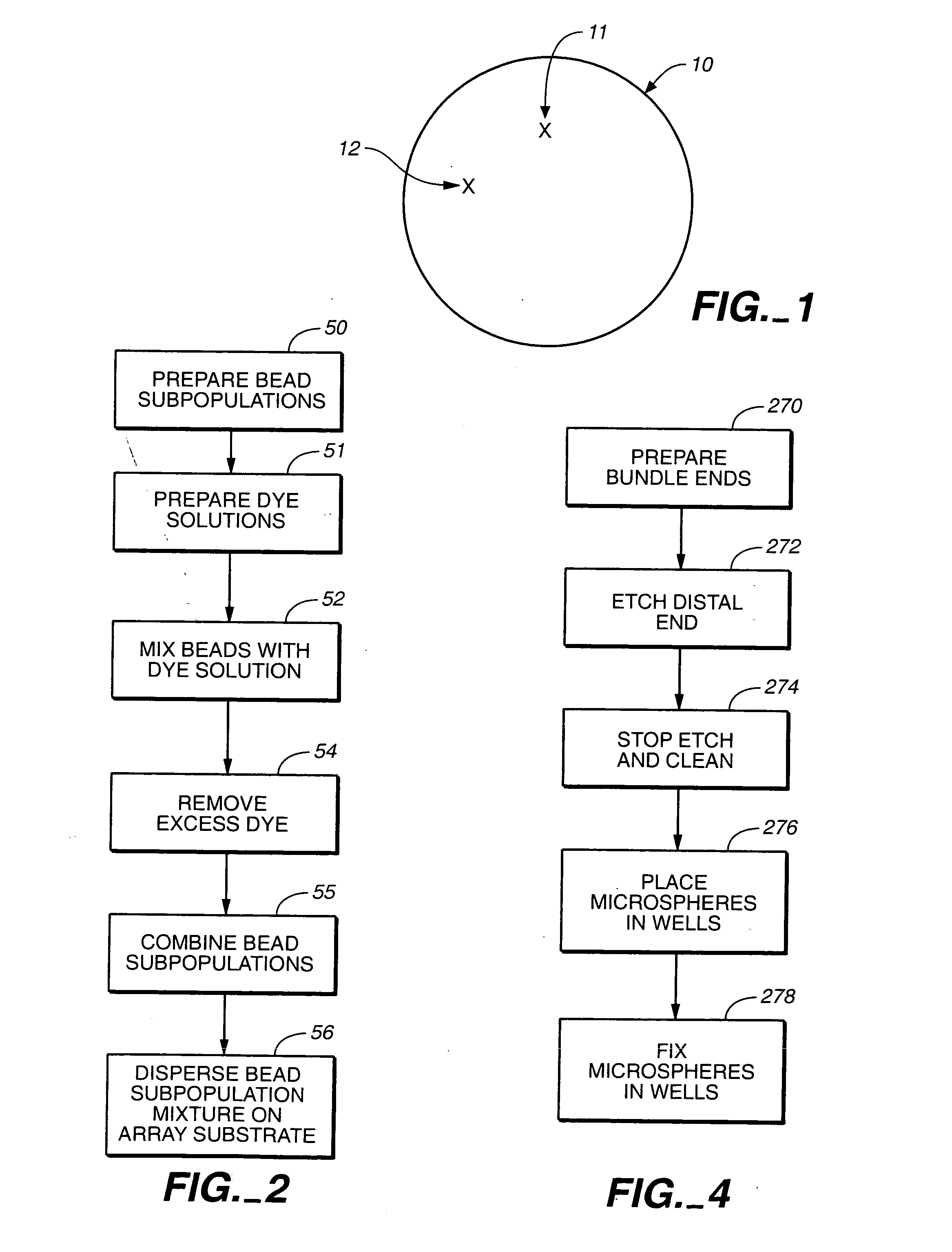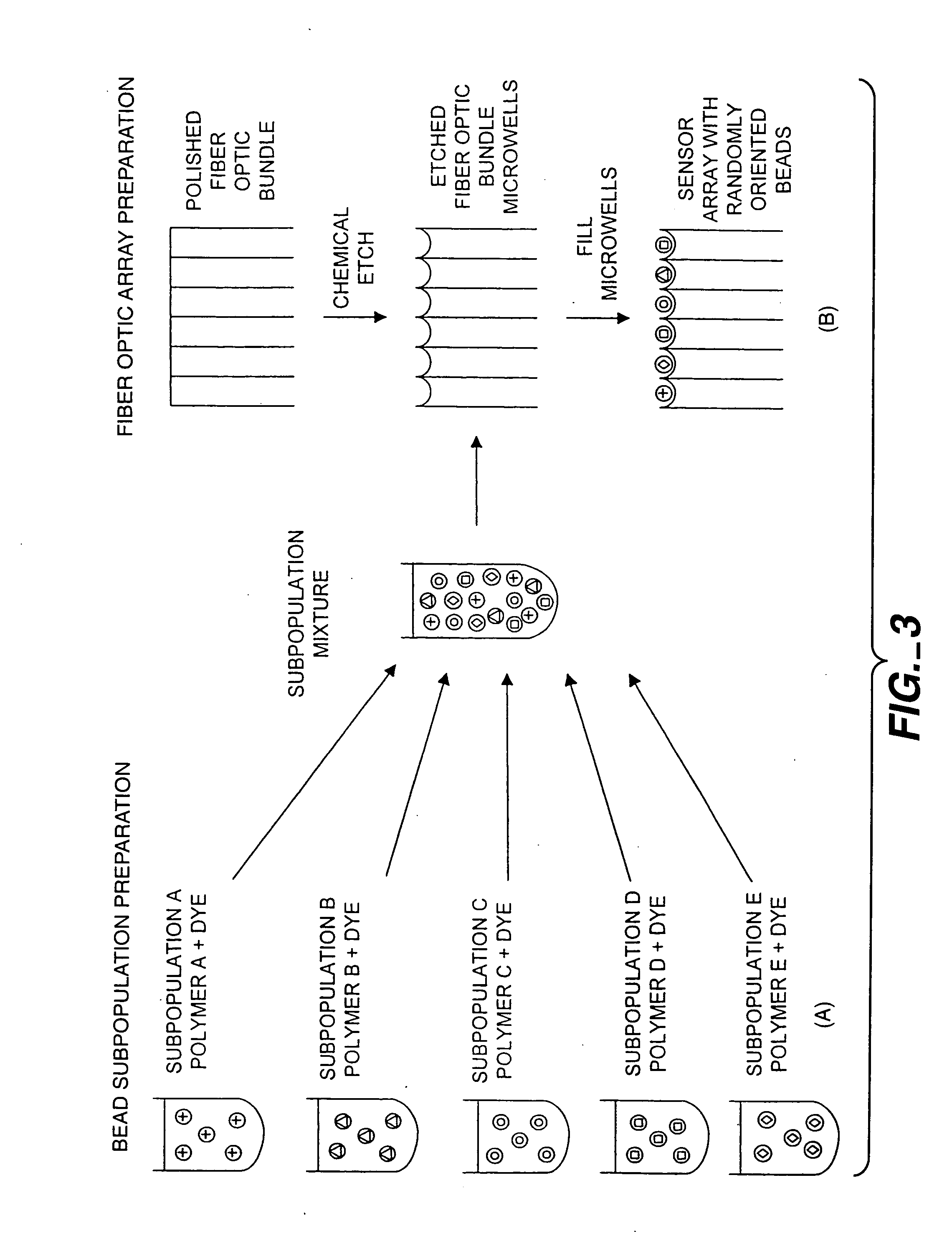Self-encoding sensor with microspheres
a self-encoding, sensor technology, applied in the direction of chemiluminescene/bioluminescence, fluorescence/phosphorescence, biomass after-treatment, etc., can solve the problem of limiting the efficacy of such devices, requiring recalibration and network retraining, and unsatisfactory element-to-element reproducibility between sensor arrays
- Summary
- Abstract
- Description
- Claims
- Application Information
AI Technical Summary
Problems solved by technology
Method used
Image
Examples
example 1
[0198] Preparation of porous silica / Nile Red beads: Approximately 0.5 cm3 of nominally 3.2 micron diameter commercial porous silica beads were removed from a LUNA column (Phenomenex, Torrance, Calif.). Sample of beads were placed onto a filter paper and, using vacuum filtration, 0.5 mL of Nile Red (Eastman Kodak, Rochester, N.Y.) solution (1 mg / mL in toluene) was poured over beads. Nile Red was immediately taken up by silica beads, turning them a deep purple color. The beads were washed repeatedly with toluene to remove any excess, non-adsorbed Nile Red. The beads were dried on a watch glass overnight. Beads were then placed into microwells formed by etching a fiber optic bundle according to the method of the present invention.
example 2
[0199] Preparation of PDPO polymer coated porous silica beads: A silanizing solution was prepared from 20 uL N-octadecyl-triethyoxysilane in 980 uL of ethanol / water (95% ethanol, 5% ultrapure water with pH adjusted to 4.9 with acetic acid). The LUNA porous silica beads of Example 1 were dispersed in an excess of silanizing solution for approximately 10 minutes, vortexing continuously. The particles were rinsed three times with ethanol and dried in a 120° C. oven, overnight for approximately 12 hours.
[0200] Stock solution of PDPO, poly(2,6-dimethyl-1,4-phenylene oxide),(Aldrich, Milwaukee, Wis.) and Nile Red was prepared from 0.09 g PDPO and 1.0 mL chloroform. After complete dissolution of the polymer, a 100 uL aliquot of 1 mg / mL nile red in chloroform was added. The resultant solution was vortexed continuously for uniform dispersion.
[0201] Excess PDPO / Nile Red was added to a small fraction of the silanized porous beads, approximately 100 uL polymer / dye solution to approximately 1 ...
example 4
[0204] Preparation of (15-20% acryloxypropylmethylsiloxane) 80-85% dimethylsiloxane copolymer beads with nile red: Approximately 25 mL of ultrapure water plus 25 mL ethanol were placed in a 100 mL round bottom flask and stirred with a stirbar at approximately 350 rpm. A mixture of 500 uL (15-20% acryloxypropylmethylsiloxane) 80-85% dimethylsiloxane copolymer, 200 uL Nile Red solution (1 mg / ml in chloroform) and 250 uL methylene chloride was made and added dropwise to the stirred water / ethanol solution. A solution of 5.5 mg AIBN, N,N′-azobis-isobutyl nitrile (2,2′-azobis-2-methylproprio-nitrile)(Phaltz & Bauer, Inc.), in methylene chloride was added to the stirring dispersion. The mixture was degassed with argon for approximately one hour and then heated to approximately 70 degrees celcius. After approximately three hours of heating, 20 mL of 0.01 % Tween 20 in ultrapure water was added to the mixture. Heating and stirring was continued for approximately 12 hours.
[0205] The mixture ...
PUM
| Property | Measurement | Unit |
|---|---|---|
| sizes | aaaaa | aaaaa |
| sizes | aaaaa | aaaaa |
| sizes | aaaaa | aaaaa |
Abstract
Description
Claims
Application Information
 Login to View More
Login to View More - R&D
- Intellectual Property
- Life Sciences
- Materials
- Tech Scout
- Unparalleled Data Quality
- Higher Quality Content
- 60% Fewer Hallucinations
Browse by: Latest US Patents, China's latest patents, Technical Efficacy Thesaurus, Application Domain, Technology Topic, Popular Technical Reports.
© 2025 PatSnap. All rights reserved.Legal|Privacy policy|Modern Slavery Act Transparency Statement|Sitemap|About US| Contact US: help@patsnap.com



